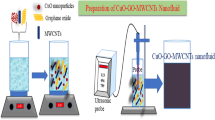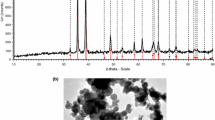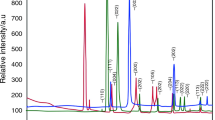Abstract
The present work aims to emphasize the improvement in thermal conductivity of magnesium oxide (MgO)/water and Multi-walled carbon nanotubes (MWCNT)/water by adding copper oxide (CuO) nanoparticles. The nanofluids were prepared on volume basis by two-step approach. Initially, two different nanofluids such as 1% MgO + 99% water and 1% MWCNT + 99% water were prepared by ultra-sonication, and the thermal conductivity of chosen fluid samples was measured experimentally by KD2 pro instrument. The Nusselt number, Reynolds number, Graetz number and heat transfer coefficient were examined at two different temperatures such as 30 °C and 40 °C. Again 1% CuO nanoparticle was mixed in above samples and two different hybrid nanofluids such as 1% CuO + 1% MgO + 98% water and 1% CuO + 1% MWCNT + 98% water were prepared. The addition of CuO in MgO/water resulted in 11.3% increase in thermal conductivity compared to MgO/water at temperature of 30 °C. Furthermore, 13.3% improvement in thermal conductivity was attained due to the inclusion of CuO in MWCNT/water at 30 °C. Similar trend was depicted at 40 °C such that the thermal conductivity was enhanced by 12.8% and 14.5% in MgO/water and MWCNT/water due to the inclusion of CuO, respectively. In addition, the nanoparticles volume fraction enhanced the nanofluids’ thermal conductivity at lower concentration only.







Similar content being viewed by others
Abbreviations
- K p :
-
Thermal conductivity of nanoparticle, W m−1 K−1
- K f :
-
Thermal conductivity of fluid, W m−1 K−1
- ɸ :
-
Nanoparticles concentration in base fluids
- n :
-
Experimental view factor
- L :
-
Width of nanoparticle, nm
- D :
-
Diameter of nanoparticle, nm
- Nu:
-
Average Nusselt number = convective heat transfer/ conductive heat transfer across a boundary
- Re:
-
Reynolds number = inertia force/viscous force
- Pr:
-
Prandtl number = molecular diffusivity of momentum/molecular diffusivity of heat
- Gz:
-
Graetz number is a dimensionless number that characterizes laminar flow in a conduit.
- Gr:
-
Grashoff number = buoyancy/viscous
- Pe:
-
Peclet number = heat flow rate by convection/heat flow rate by conduction
- BF:
-
Base fluid
- NF:
-
Nanofluid
- NF1 :
-
Nanofluid with CuO and water
- NF2 :
-
Nanofluid with CuO, MgO and water
- NF3 :
-
Nanofluid with CuO, MWCNT and water
- NFA :
-
Nanofluid with MgO and water
- NFB :
-
Nanofluid with MWCNT and water
- NF#1T1 :
-
Nanofluid with CuO and water at 30 ºC
- NF#1T1 :
-
Nanofluid with CuO and water at 40 ºC
- NF#AT1 :
-
Nanofluid with MgO and water at 30 ºC
- NF#AT2 :
-
Nanofluid with MgO and water at 40 ºC
- NF#2T1 :
-
Nanofluid with CuO, MgO and water at 30 ºC
- NF#2T2 :
-
Nanofluid with CuO, MgO and water at 40 ºC
- NF#BT1 :
-
Nanofluid with MWCNT and water at 30 ºC
- NF#BT2 :
-
Nanofluid with MWCNT and water at 40 ºC
- NF#3T1 :
-
Nanofluid with CuO, MWCNT and water at 30 ºC
- NF#3T2 :
-
Nanofluid with CuO, MWCNT and water at 40 ºC
- U :
-
Overall heat transfer coefficient, W m−2 K−1
- h :
-
Heat transfer coefficient, W m−2 K−1
- µ b :
-
Dynamic viscosity of base heat transfer fluid, Ns m−2
- µ w :
-
Dynamic viscosity of water, Ns m−2
References
Lee S, Choi SUS, Li S, Eastman JA. Measuring thermal conductivity of fluids containing oxide nanoparticles. J Heat Transfer. 1999;121:280–9. https://doi.org/10.1115/1.2825978.
Sadeq R, Nfawa AR, Talib A, Basri AA, Masuri SU. Novel use of MgO nanoparticle additive for enhancing the thermal conductivity of CuO/water nanofluid. Case Stud Therm Eng. 2021;27:101279. https://doi.org/10.1016/j.csite.2021.101279.
Rohit S, Khedkar SS, Sonawane KL, Wasewar. Influence of CuO nanoparticles in enhancing the thermal conductivity of water and monoethylene glycol based nanofluids. Int Commun Heat Mass Transf. 2012;39:665–9. https://doi.org/10.1016/j.icheatmasstransfer.2012.03.012.
Kumar N, Shriram S, Sonawane. Experimental study of thermal conductivity and convective heat transfer enhancement using CuO and TiO2 nanoparticles. Int Commun Heat Mass Transf. 2016;76:98–107. https://doi.org/10.1016/j.icheatmasstransfer.2016.04.028.
Dehkordi BAF, Abdollahi A. Experimental investigation toward obtaining the effect of interfacial solidliquid interaction and basefluid type on the thermal conductivity of CuO loaded nanofluids. Int Commun Heat Mass Transf. 2018;97:151–62. https://doi.org/10.1016/j.icheatmasstransfer.2018.08.001.
Lin H, Jian Q, Bai X, Li D, Huang Z, Huang W, Feng S, Cheng Z. Recent advances in thermal conductivity and thermal applications of graphene and its derivatives nanofluids. Appl Therm Eng. 2023;218:119176. https://doi.org/10.1016/j.applthermaleng.2022.119176.
Xuan Y, Roetzel W. Conceptions for heat transfer correlations of nanofluids. Int J Heat Mass Transf. 2000;47:3701–7. https://doi.org/10.1016/S0017-9310(99)00369-5.
Mao M, Lou D, Wang D, Younes H, Hong H, Chen H, Peterson GP. Ti3C2 Tx MXene nanofluids with enhanced thermal conductivity. Chem Therm Therm Anal. 2022;8:100077. https://doi.org/10.1016/j.ctta.2022.100077.
Xie H, Wang J, Xi T, Liu Y. Thermal conductivity of suspensions containing nanosized SiC particles. Int J Thermophys. 2002;23:571–80. https://doi.org/10.1023/A:1015121805842.
Choi SUS, Zhang ZG, Yu W, Lockwood FE, Grulke EA. Anomalous thermal conductivity enhancement in nanotube suspensions. Appl Phys Lett. 2001;79:2252–4. https://doi.org/10.1063/1.1408272.
Xie H, Wang J, Xi T, Liu Y, Ai F, Wu Q. Thermal conductivity enhancement of suspensions containing nanosized alumina particles. J Appl Phys. 2002;91:4568–72. https://doi.org/10.1063/1.1454184.
Xie H, Wang J, Xi T, Liu Y, Ai F. Thermal conductivity of suspensions containing SiC particles. J Mater Sci Lett. 2002;21:193–5. https://doi.org/10.1023/A:1014742722343.
Bicerano J, Douglas JF, Brune DA. Model for the viscosity of particle dispersions. J Macromol Sci Part C Polym Rev. 1999;39:561–642. https://doi.org/10.1081/MC-100101428.
Hamilton RL, Crosser OK. Thermal conductivity of heterogeneous two-component system. IEC Fundam. 1962;1:182–91. https://doi.org/10.1021/i160003a005.
Keblinski P, Philpot SR, Choi SUS, Eastman JA. Mechanisms of heat flow in suspensions of nano-sized particles (nanofluids). Int J Heat Mass Transf. 2002;45:855–63. https://doi.org/10.1016/S0017-9310(01)00175-2.
Li Q, Xuan Y. Experimental investigation on convective heat transfer of nanofluids. J Eng Thermophys. 2002;23:721–3. https://doi.org/10.1016/j.ijheatmasstransfer.2004.07.012.
Li Q, Xuan Y. Convective heat transfer and flow characteristics of Cu-water nanofluid. Sci China Series E Technol Sci. 2002;45:408–16. https://doi.org/10.1360/02ye9047.
Sieder EN, Tate GE. Heat transfer and pressure drop of liquids in tubes. Ind Eng Chem. 1936;38:1429–35. https://doi.org/10.1021/ie50324a027.
Oliver DR. Effect of natural convection on viscous-flow heat transfer in horizontal tubes. Chem Eng Sci. 1962;17:335–50. https://doi.org/10.1016/0009-2509(62)80035-9.
Eubank CC, Proctor WS. Effect of natural convection on heat transfer with laminar flow in tubes. M.Sc. Thesis in Chemical Engineering, Massachusetts Institute of Technology, Cambridge, MA, 1951. https://doi.org/10.1016/0017-9310(95)00040-G
Nagasaka Y, Nagashima A. Absolute measurement of the thermal conductivity of electrically conducting liquids by the transient hot-wire method. J Phys E Sci Instrum. 1981;14:1435–40. https://doi.org/10.1088/0022-3735/14/12/020.
Senthilkumar G, Kumar PP, Gowtham RS. Performance of radiator by using SiO2 nanofluids. Int J Ambient Energy. 2020;41:1038–340. https://doi.org/10.1080/01430750.2018.1501746.
Anish M, Senthilkumar G, Kanimozhi B, Beem kumar N, Arunkumar T. Performance study of domestic refrigerator using CuO/Al2O3-R22 refrigerant as a working fluid. Int J Ambient Energy. 2020;41:152–6. https://doi.org/10.1080/01430750.2018.1451376.
Senthilkumar G, Ramachandran S, Purushothaman M. Indigenous development of automobile radiator using CFD. IEEE Explore. 2010. https://doi.org/10.1109/FAME.2010.5714862.
Izadi M, Tayebi T, Alshehri HM, et al. Transient magneto-buoyant convection of a magnetizable nanofluid inside a circle sensible storage subjected to double time-dependent thermal sources. J Therm Anal Calorim. 2023. https://doi.org/10.1007/s10973-023-12242-w.
Hartman Kok PJA, Kazarian SG, Lawrence CJ, Briscoe BJ. Near-wall particle depletion in a flowing colloidal suspension. J Rheol. 2002;46:481–93. https://doi.org/10.1122/1.1446882.
Ying Y, George Zhang Z, Eric AG, William BA, Gefei W. Heat transfer properties of nanoparticle-in-fluid dispersions (nanofluids) in laminar flow. Int J of Heat Mass Trans. 2004. https://doi.org/10.1016/j.ijheatmasstransfer.2004.09.038.
Zhou L, Jiewei Z, Yifan Z, Honghe M. A molecular dynamics study on thermal conductivity enhancement mechanism of nanofluids –effect of nanoparticle aggregation. Int J Heat Mass Trans. 2022;183:122–4. https://doi.org/10.1016/j.ijheatmasstransfer.2021.122124.
Senthilkumar G, Saravanan K, Ajaykumar K. Investigation on nano refrigeration system. IOP conf ser. 2017;197:012028. https://doi.org/10.1088/1757-899X/197/1/012028.
Sobhanadri A, Senthilkumar G, Vivekanandan M, Venkatesh R, Ramkumar R, Dawit T, Parthipan N. A CFD investigation and heat transfer augmentation of double pipe heat exchanger by employing helical baffles on shell and tube side. Therm Sci. 2022;26:991–8. https://doi.org/10.2298/TSCI201120300A.
Beemkumar N, Yuavarajan D, Arulprakasajothi M, Ganesan S, Elangovan K, Senthilkumar G. Experimental investigation and numerical modeling of room temperature control in buildings by the implementation of phase change material in the roof. ASME J Sol Ener Eng. 2019. https://doi.org/10.1115/1.4044564.
Javed M. Synthesis of stable waste palm oil based CuO nanofluid for heat transfer applications. Heat Mass Transf. 2018;54:3739–45. https://doi.org/10.1007/s00231-018-2399-y.
Nemade K, Waghuley S. A novel approach for enhancement of thermal conductivity of CuO/H2O based nanofluids. Appl Therm Eng. 2016;95:271–4. https://doi.org/10.1016/j.applthermaleng.2015.11.053.
Ettefaghi E, Ahmadi H, Rashidi A, Mohtasebi S, Alaei M. Experimental evaluation of engine oil properties containing copper oxide nanoparticles as a nanoadditive. Int J Ind Chem. 2013;4:1–6. https://doi.org/10.1186/2228-5547-4-28.
Agarwal R, Verma K, Agrawal NK, Duchaniya RK, Singh R. Synthesis, characterization, thermal conductivity and sensitivity of CuO nanofluids. Appl Therm Eng. 2016;102:1024–36. https://doi.org/10.1016/j.applthermaleng.2016.04.051.
Zhu HT, Zhang CY, Tang YM, Wang JX. Novel synthesis and thermal conductivity of CuO nanofluid. J Phys Chem. 2007;111:1646–50. https://doi.org/10.1021/jp065926t.
Karimipour A, Ghasemi S, Darvanjooghi MHK, Abdollahi A. A new correlation for estimating the thermal conductivity and dynamic viscosity of CuO/liquid paraffin nanofluid using neural network method. Int Commun Heat Mass Transf. 2018;92:90–9. https://doi.org/10.1016/j.icheatmasstransfer.2018.02.002.
Suganthi KS, Radhakrishnan AK, Anusha N, Rajan KS. Influence of nanoparticle concentration on thermo-physical properties of CuO-propylene glycol nanofluids. J Nanosci Nanotechnol. 2014;14:4602–7. https://doi.org/10.1166/jnn.2014.8657.
Shah J, Kumar S, Ranjan M, Sonvane Y, Thareja P, Gupta SK. The effect of filler geometry on thermo-optical and rheological properties of CuO nanofluid. J Mol Liq. 2018;272:668–75. https://doi.org/10.1016/j.molliq.2018.09.117.
Wang Y, Fisher T, Davidson J, Jiang L. Thermal conductivity of nanoparticle suspensions. Thermo phyHeat Transf Conf. 2002. https://doi.org/10.2514/6.2002-3345.
Xie H, Yu W, Chen W. MgO nanofluids: higher thermal conductivity and lower viscosity among ethylene glycol-based nanofluids containing oxide nanoparticles. J Exp Nanosci. 2010;5:463–72. https://doi.org/10.1080/17458081003628949.
Suresh S, Venkitaraj KP, Selvakumar P, Chandrasekar M. Synthesis of Al2O3–Cu/water hybrid nanofluids using two step method and its thermo physical properties. Coll Surf A Phys chem Eng. 2011;388:41–8. https://doi.org/10.1016/j.colsurfa.2011.08.005.
Biswas N, Sarkar UK, Chamkha AJ, Manna NK. Magneto-hydrodynamic thermal convection of Cu–Al2O3/water hybrid nanofluid saturated with porous media subjected to half-sinusoidal nonuniform heating. J Therm Anal Calorim. 2021;143:1727–53. https://doi.org/10.1007/s10973-020-10123-0.
Hemmat EM. Thermal conductivity of Cu/TiO2-water/EG hybrid nanofluid: experimental data and modeling using artificial neural network and correlation. Int Comm Heat Mass Tran. 2015;66:100–4. https://doi.org/10.1016/j.icheatmasstransfer.2015.05.014.
Esfe MH, Arani AAA, Rezaie M, Yan WM, Karimipour A. Experimental determination of thermal conductivity and dynamic viscosity of Ag–MgO/water hybrid nanofluid. Int Comm Heat Mass Transf. 2015;66:189–95. https://doi.org/10.1016/j.icheatmasstransfer.2015.06.003.
Hemmat Esfe M, Yan WM, Akbari M, Karimipour A, Hassani M. Experimental study on thermal conductivity of DWCNT-ZnO/water-EG nanofluids. Int Comm Heat Mass Transf. 2015. https://doi.org/10.1016/j.icheatmasstransfer.2015.09.001.
Li X, Wang H, Luo B. The thermophysical properties and enhanced heat transfer performance of SiC-MWCNTs hybrid nanofluids for car radiator system. Coll Surf A Phys chem Eng Asp. 2021;61:125968. https://doi.org/10.1016/j.colsurfa.2020.125968.
Kamel MS, Al O, Lezsovits F. Thermal conductivity of Al2O3 and CeO2 nanoparticles and their hybrid based water nanofluids: an experimental study. Chem Eng. 2020;65:50–60. https://doi.org/10.3311/PPch.15382.
Tiwari AK, Pandya NS, Said Z, Oztop HF, Abu H. 4S consideration (synthesis, sonication, surfactant, stability) for the thermal conductivity of CeO2 with MWCNT and water based hybrid nanofluid: an experimental assessment. Colls Surf A Phys chem Eng. 2020. https://doi.org/10.1016/j.colsurfa.2020.125918.
Mbambo MC. Thermal conductivity enhancement in gold decorated graphene nanosheets in ethylene glycol based nanofluid. Sci Rep. 2020;10:1–10. https://doi.org/10.1038/s41598-020-71740-1.
Kishore PS, Sireesha V, Sree Harsha V, Dharma Rao V, Brusly SA. Preparation, characterization and thermo-physical properties of Cu-graphene nanoplatelets hybrid nanofluids. Mater Today Proc. 2020. https://doi.org/10.1016/j.matpr.2019.12.108.
Hemmat Esfe M, Behbahani PM, Arani AAA, Sarlak MR. Thermal conductivity enhancement of SiO2–MWCNT (85:15%)–EG hybrid nanofluids: ANN designing, experimental investigation, cost performance and sensitivity analysis. J Therm Anal Calorim. 2017;128:249–58. https://doi.org/10.1007/s10973-016-5893-9.
Sajid MU, Ali HM. Thermal conductivity of hybrid nanofluids: a critical review. Int J Heat Mass Transf. 2018. https://doi.org/10.1016/j.ijheatmasstransfer.2018.05.021.
Qing SH, Rashmi W, Khalid M, Gupta T, Nabipoor M, Hajibeigy MT. Thermal conductivity and electrical properties of hybrid SiO2-graphene naphthenic mineral oil nanofluid as potential transformer oil. Mater Res Exp. 2017;4:15504. https://doi.org/10.1088/2053-1591/aa550e.
Senthilkumar G, Vijayan ML, Lokesh T. Examining nanoparticles with different laser wavelengths in liquid environment. Env Qua Mgmt. 2023. https://doi.org/10.1002/tqem.21962.
Yarmand H. Graphene nanoplatelets–silver hybrid nanofluids for enhanced heat transfer. Energy Conv Manag. 2015;100:419–28. https://doi.org/10.1016/j.enconman.2015.05.023.
Sundar LS, Singh MK, Sousa ACM. Turbulent heat transfer and friction factor of nanodiamond-nickel hybrid nanofluids flow in a tube: an experimental study. Int J Heat Mass Transf. 2018;117:223–34. https://doi.org/10.1016/j.ijheatmasstransfer.2017.09.109.
Esfe MH, Arani AAA, Firouzi M. Empirical study and model development of thermal conductivity improvement and assessment of cost and sensitivity of EG-water based SWCNT-ZnO (30%: 70%) hybrid nanofluid. J Mol Liq. 2017;244:252–61. https://doi.org/10.1016/j.molliq.2017.08.087.
Author information
Authors and Affiliations
Corresponding author
Ethics declarations
Conflict of interest
There is no conflict of interest.
Additional information
Publisher's Note
Springer Nature remains neutral with regard to jurisdictional claims in published maps and institutional affiliations.
Rights and permissions
Springer Nature or its licensor (e.g. a society or other partner) holds exclusive rights to this article under a publishing agreement with the author(s) or other rightsholder(s); author self-archiving of the accepted manuscript version of this article is solely governed by the terms of such publishing agreement and applicable law.
About this article
Cite this article
Amburi, P.K., Senthilkumar, G. & Nithya, A. Novel use of CuO nanoparticles additive for improving thermal conductivity of MgO/water and MWCNT/water nanofluids. J Therm Anal Calorim 148, 10389–10398 (2023). https://doi.org/10.1007/s10973-023-12374-z
Received:
Accepted:
Published:
Issue Date:
DOI: https://doi.org/10.1007/s10973-023-12374-z




